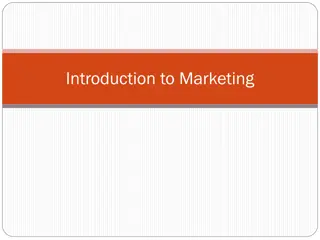Creating and Retaining Value for Customers: An Introduction to Marketing for Aspiring Sport Entrepreneurs
Gain insight into how businesses generate value for clients, organizations, and stakeholders. Explore key marketing concepts and strategies, such as the Marketing Mix, value interpretation, and core variables. Understand the significance of socio-economic contexts and people in building value for your business idea.
Download Presentation

Please find below an Image/Link to download the presentation.
The content on the website is provided AS IS for your information and personal use only. It may not be sold, licensed, or shared on other websites without obtaining consent from the author.If you encounter any issues during the download, it is possible that the publisher has removed the file from their server.
You are allowed to download the files provided on this website for personal or commercial use, subject to the condition that they are used lawfully. All files are the property of their respective owners.
The content on the website is provided AS IS for your information and personal use only. It may not be sold, licensed, or shared on other websites without obtaining consent from the author.
E N D
Presentation Transcript
Creating and retaining value for customers: Creating and retaining value for customers: an introduction to Marketing for aspiring an introduction to Marketing for aspiring sport entrepreneurs sport entrepreneurs
1.O 1.Objectives & bjectives & Goals Goals At At the the end end of of this this module module, , you youwill will be be able able to to: : Better understand how businesses generate values Better understand how businesses generate values for the clients, the organisation and all people involved. Frame the role of marketing in this value Frame the role of marketing in this value- -generation process generation process You will be introduced to the very essentials of Marketing discipline and defining pillars Outline the essentials of your Marketing strategy Outline the essentials of your Marketing strategy We will highlight the variables representing the very core of Marketing strategies to reach clients and market segments of interest
Index Index Unit 1 Unit 1 Unit 2 Unit 2 Unit 3 Unit 3 The Marketing Mix Framing the concept of value for organizations: so what is Marketing about? 1. The Marketing Mix: 8Ps Model 2. The Marketing Mix in the Business Plan 1. The many interpretations of value 2. Variables of value s equation 3. Socio-economic context of a given time and period 4. Inputs processing 5. People 1. A definition 2. Needs and wants 3. Types of Marketing based on operative context 4. Types of Marketing based on focus 5. Products 6. Sales 7. Marketing 8. Relations
Unit Unit1 1 What do we mean by value? Quantitative VS Qualitative How much has been achieved in a given period of time VS performance standards and efficiency Output VS Outcome Tangible and concrete results VS medium/long-term impact generating from that output (i.e., profit) (profit) = R (revenues) C (costs)
Unit Unit1 1 Variables of value s equation Regardless of the actual scale and scope of any business idea, value in its broader sense is built from three explicit variables: Inputs processing Socio-economic context People
Unit Unit1 1 Variables of value s equation Socio-economic context of a given time and period It refers to the overall scale of phenomena that might have an influence on your business idea. Technologies and market trends represent two of the most impactful trends that (aspiring) entrepreneurs look into to design and scale-up their business idea.
Unit Unit1 1 Variables of value s equation Socio-economic context of a given time and period, e.g.: Throughout the last couple of years, e- gaming became a huge thing, with many established companies capitalising phenomenon sport-related on the like already done by Juventus F.C. in 2019, with the public announcement of Club s very own e-sport team in view the Global eFootball.pro Championship. Source: https://www.juventus.com/it/news/articoli/la-juventus-entra-nel-mondo-esports
Unit Unit1 1 Variables of value s equation Socio-economic context of a given time and period Generally speaking, this dimension refers also to: Competitors strengths and weaknesses Customers actual and potential Due to the typical scale and scope of sport-related business ideas, it is relatively easier to find specific market segments at high profitability margins.
Unit Unit1 1 Variables of value s equation Socio-economic context of a given time and period finding a niche More than in other markets, clients of sport industry: Are very well-informed Tempt to aggregate in (online) communities Cluster in well-recognizable segments Have higher spending potential
Unit Unit1 1 Variables of value s equation Environment Inputs processing The value generation process falls under a framework that is common to all business. Inputs Inputs Inputs It is the so defined IPO model: Input Process Process Output OUTPUT
Unit Unit1 1 Variables of value s equation Inputs processing INPUT PROCESS OUTPUTS OUTCOME Raw materials Information Knowledge Services Outputs from previous IPO s cycles Semi finished products Finance Logistic Administration Human Resource People Management Communication Public Relations Marketing Final product Final service Deliverable Know how Skills Competitiveness Profitability Sustainability Brand awareness Clients satisfaction Effectiveness Efficiency
Unit Unit1 1 Variables of value s equation Inputs processing In business studies, we tempt to consider Marketing among those activities defined as Primary*. Contributing in first hand to reach the final client and generate revenues. * Interpretation based on Porter s Value Chain: Competitive Advantage, 1985, p.87
Unit Unit1 1 Variables of value s equation People With People, we refer both to: Internal workforce* knowledge, expertise, skills and competences ! Those who make things happen ! External Stakeholders groups of interest, and more in general, whoever might have an interest on business activities *Contrary to Marketing, HR and People Management fall under Support activities instrumental for a smooth implementation of Primaries.
Unit 2 Unit 2 so what is Marketing about? Based on public opinion, there is a lot of misconception on what it is marketing about. Is it about sales? Communication and promotion? Public engagement? Customer relationship? In reality, it includes all of the above, and even beyond.
Unit 2 Unit 2 Couple of pinpoints: American Marketing Association (AMA) [Marketing is] the activity, set of institutions, and processes for creating, communicating, delivering, and exchanging offerings that have value for customers, clients, partners, and society. AMA s Marketing definition is very market-centred, including a wide range of activities and tasks aimed at satisficing not only customers satisfaction, but that of civil society and general public at large.
Unit 2 Unit 2 Couple of pinpoints: Philip Kotler Considered representative according to Philip Kotler: by many Marketing s as one expert of the worldwide, most [Marketing is] the process by which companies engage customers, build relationships, and create customer value in order to capture value from customers in return. strong customer Compared to AMA, Kotler s definition is much more customer-centred. Image source
Unit 2 Unit 2 Needs and wants In sport industry as in any other market Marketing practices based their approach(es) on three everlasting pillars: MARKET(S) NEEDS DEMAND The which your business operates in competitive context in Lags and overall mismatches in customers satisfaction that you can exploit in your favour: Customers willingness to pay a certain amount to purchase a given good / service. This really depends on: What established) alternative to your offer? What technologies communication medias your competitors are relying on? are current (and doing something better / something new already done competitors. than by what your Perceived quality Competitors counter-offer Services (i.e., assistance) / after sale
Unit 2 Unit 2 Types of Marketing based on operative context Business Customers (B2C) In sport-related industries, it is most likely that you will orientate your marketing activities to final consumers (B2C) or retailers / other actors of the production chain. Business Business (B2B) In sport-related industries, it is most likely that you will rely on this kind of formula when experiencing with influencers social media campaigns. Customer Business (C2B) Marketing framework that applies to sharing economy s businesses very unusual for sport-related industries. Customer Customer (C2C)
Unit 2 Unit 2 Types of Marketing based on focus Focus on PRODUCT Origins: early 900s Pioneered by: Quoting Henry Ford: If you have a really good thing, it will advertise itself. In Product-driven strategies, Marketing efforts are aimed at valorising technological / technical / design competitiveness of the given good or service. Image source
Unit 2 Unit 2 Types of Marketing based on focus Focus on SALES Origins: early 30s Pioneered by: In the early days, Coca Cola was also fostering a Product-lead approach. This was until Marketing Unit realised that, despite their efforts, the company experienced cyclical falls in demand during winter months...how did they overcome this issue? By associating recognizable imagery the brand to Image source
Unit 2 Unit 2 Types of Marketing based on focus Focus on MARKETING Origins: 80s Pioneered by: During 1984 Super Bowl, Apples launched the First Macintosh Commercial. The message of the commercial is subtle but genial reference to Orwell s best seller. As of today, this 1-min spot is considered one of the most impactful best practice in media and communication the ad do the talk for the product, without even showing it on camera Image source
Unit 2 Unit 2 Types of Marketing based on focus Focus on RELATIONS Origins: 00s current Pioneered by: and many others Users and clients generates content for other users and clients in a never- stopping cycle that nurtures by itself. These feedbacks loops and mutual engagement mechanisms among participants helps these brand in retaining a loyal customer base than finds enjoyment in spending time in these platform for the benefit of advertisers.
Unit 2 Unit 2 What s the best for your sport-related business? there is not a unilateral answer, it really depends on what is the underlie value of your offer. Are you developing high-tech running sneakers? Are you developing a webzine for off-road bikers? Are you developing a new hydrophobic swimsuit? Are you developing eco-friendly gym elastic band? Are you developing an app to monitor athletic performance? Product Relation Product Sales Sales Etc
Unit 3 Unit 3 The Marketing Mix How do you come up with a marketing plan? What elements should you focus on?...Let us introduce you to the 8Ps Model: 1. Product 2. Price 3. Place 4. Promotion 5. People 6. Process 7. Physical evidence 8. Partnership Each of the mentioned represents an asset on which entrepreneurs rely on to give content and format to the many possible ways they can reach their market of interest (e.g., off-road bikers, runners, swimmers, etc.).
Unit 3 Unit 3 The Marketing Mix in detail but in brief 1. Product 2. Price 3. Place 4. Promotion 5. People 6. Process 7. Physical evidence 8. Partnership What are you selling At what price Where physical store? Online? How are you going to communicate it eMedia? Who s collaborating with you in this journey? Organisation of primary and secondary activities Product design and branding Cogenerating value for the whole production chain Bear in mind 1. Even the slightest change in one of the aforementioned will impact (at least!) one of the others. 2. Make sure to compile all information into a formal Marketing Plan
Unit 3 Unit 3 The Marketing Mix in the Business Plan The business plan is the formal document detailing the main assets of the business, in term of: Executive Summary summary of the business plan Business leadership founders Offer product / service, and how they mix Covered market(s) customers & competitors Distribution and Marketing Business model coordination of activities and processes Legal form Risk assessment mapping & identification Capital requirements Financial projections cash flow, balance sheet, income statement Miscellaneous, i.e. Staff CVs, surveys and analysis, etc. These are the typical sections in which you will provide for very precise information about your marketing mix. Recommendation: For a better reader s understanding, you can attach your whole marketing plan in annex to the business plan
Unit 3 Unit 3 Last but not least Word of mouth: a threat or an opportunity? It really depends on how your offer is perceived by clients. Positive reviews it s free publicity, customers contribute to market the product themselves, without even being aware of it Tip: surf the wave and let the momentum going Negative reviews for a reason or another, you failed to satisfy a customer. Any negative-positive ratio greater than 1:5 (2:5 or worse) should concern you, dropping exponentially your opportunities to engage you customers. Tip: take action immediately, be polite and seek for more precise feedbacks from the very same angry customers you want to do whatever possible to increase your chances to establish a clean reputation.
Summing Summing up up Business Value: 3 pillars The Marketing Mix 1. Inputs processing Product 2. People Price 3. Socio-economic context Place Promotion IPO MODEL: from input(s) to outcomes(s) People Process Physical evidence Partnership UnderstandingMarketing Definitions. customer-centred(Kotler) Types of Marketing based on operative context and focus Market-centred (AMA) and
Self Self- -assessment test assessment test Question 1: What the IPO model? Question 2: What is a common definition of Market s demand? Question 3: Which type of Marketing leverages on offer s technical features to drive sales? Question 4: Which type of Marketing is the best suited for sport industry? Question 5: What is the Marketing Mix?























